The Impact of Policy and Technology Parameters on the Economics of Microgrids for Rural Electrification: A Case Study of Remote Communities in Bolivia
Abstract
1. Introduction
- We offer a model that uses various operating strategies to simulate the annual operation of remote microgrids, enabling the study of the impacts that different parameters have on the optimal design of remote microgrids.
- We analyzed case studies of three remote communities in Bolivia, making our findings more rigorous. Unlike grid-connected microgrids, where the site characteristics can differ significantly due to different utility tariffs, local ancillary services, and various regulatory and policy differences (i.e., net metering and demand response), remote microgrids have fewer site differences. Therefore, the conclusions in this study can be easily extended to other remote microgrids in different locations.
- Through sensitivity analyses, we identified five key policies and technological parameters that had the most impact on the design of remote microgrids. Detailed scenario analyses were used to find the effects of these parameters on the configuration, LCOE, REP, and pollutant emissions.
2. Related Work
3. MDSTool Model Formulations
3.1. MDSTool Overview
3.2. MDSTool Performance Model
3.2.1. Objective Function
- Power balance constraints ensure that the total power produced in the microgrid is equal to the total power consumed.where PLOAD is the load demand, is the output power of DER technologies, both RESs and non-RESs, j is the index of DER technologies. Power loss is assumed to be negligible and therefore not included in the above equation. This assumption is widely adopted in microgrid due to the small size of the distribution network.
- Operation constraints ensure that all DERs operate within their minimum and maximum power, and that grid purchase and sale do not exceed their maximum limits:
- Ramp-up/ramp-down constraints ensure that all DERs do not increase or decrease power beyond their ramp-up/ramp-down limits:
3.2.2. Operating Strategy
3.2.3. Reliability Metric
3.3. MDSTool Economic Model
3.3.1. Cash Flow
3.3.2. Evaluation Metric
4. Case Study
4.1. Descriptions of the Communities
4.2. Electricity Demand Assessment
4.3. Weather Resources Analysis
4.4. DER Technical Parameters
4.5. DER Costs
4.6. Financial Parameters and Assumption
5. Results and Discussion
5.1. Cases and Scenarios Definition
5.2. Base Case Results and Analysis
5.3. Sensitivity Analysis
5.4. Scenario Analysis
5.4.1. Scenario 1: Discount Rate
5.4.2. Scenario 2: Diesel Price
5.4.3. Scenario 3: Grants
5.4.4. Scenario 4: Battery Technology
5.4.5. Scenario 5: Operating Strategy
5.5. Discussion
5.5.1. Implications for Policymakers
5.5.2. Implications for Microgrid Planners
6. Conclusions
Author Contributions
Funding
Conflicts of Interest
Acronyms
| CAPEX | Capital expenditure |
| CC | Cycle-charging |
| BES | Battery energy storage |
| DER | Distributed energy resources |
| DG | Diesel generator |
| EMR | Emission reduction |
| ESS | Energy storage system |
| FLA | Flooded lead-acid battery |
| LCOE | Levelized cost of energy |
| LF | Load-following |
| LF-OFF/ON | Load-following off/on |
| LFP | Lithium iron phosphate |
| LOLP | Loss-of-load-probability |
| LPG | Liquefied petroleum gas |
| LPSP | Loss of power supply probability |
| MILP | Mixed-integer linear programming |
| NMC | Lithium nickel manganese cobalt oxide |
| NFB | Non-forecast based |
| OPEX | Operating expenditure |
| PV | Photovoltaic |
| REP | Renewable energy penetration |
| RES | Renewable energy sources |
| VRFB | Vanadium redox flow batteries |
| VRLA | Valve-regulated lead-acid batteries |
| WT | Wind turbine |
| ZBFB | Zinc bromine flow batteries |
Appendix A
| Community | Parameters | Ref. System | S1A (10%) | S1B (3%) | S1C (5%) | S1D (7.5%) |
|---|---|---|---|---|---|---|
| Cachuela Esperanza | PV (kW) | - | 295 | 375 | 350 | 325 |
| BES (kWh) | - | 780 | 850 | 850 | 825 | |
| REP (%) | 0 | 80.5 | 87.7 | 86.4 | 84.3 | |
| LCOE ($/kWh) | 0.506 | 0.398 | 0.275 | 0.309 | 0.354 | |
| Emission (ton/y) | 315.7 | 63.6 | 39.8 | 44.2 | 51.2 | |
| Rosario del Yata | PV (kW) | - | 160 | 200 | 180 | 165 |
| BES (kWh) | - | 400 | 525 | 475 | 415 | |
| REP (%) | 0 | 74.6 | 83.9 | 80.4 | 76.0 | |
| LCOE ($/kWh) | 0.543 | 0.431 | 0.302 | 0.338 | 0.384 | |
| Emission (tCO2/y) | 175.2 | 44.6 | 28.2 | 34.3 | 42.1 | |
| Villa Bella | PV (kW) | - | 90 | 110 | 100 | 95 |
| BES (kWh) | - | 225 | 300 | 275 | 250 | |
| REP (%) | 0 | 78.1 | 86.3 | 83.5 | 81.1 | |
| LCOE ($/kWh) | 0.690 | 0.501 | 0.340 | 0.384 | 0.442 | |
| Emission (ton/y) | 116.3 | 26.0 | 16.2 | 19.5 | 22.4 |
| Community | Parameters | Ref. System | S2A (1.41 $/l) | S2B (0.82 $/l) | S2C (0.74 $/l) | S2D (0.55 $/l) | S2E (0.16 $/l) |
|---|---|---|---|---|---|---|---|
| Cachuela Esperanza | PV (kW) | - | 295 | 110 | 110 | 100 | - |
| BES (kWh) | - | 780 | 110 | 110 | 110 | - | |
| REP (%) | 0 | 80.5 | 32.6 | 32.6 | 30.9 | 0 | |
| LCOE ($/kWh) | 0.506 | 0.398 | 0.317 | 0.301 | 0.263 | 0.144 | |
| Emission (ton/y) | 315.7 | 63.6 | 216.6 | 216.6 | 222.5 | 315.7 | |
| Rosario del Yata | PV (kW) | - | 160 | 55 | 55 | 50 | - |
| BES (kWh) | - | 400 | 40 | 40 | 40 | - | |
| REP (%) | 0 | 74.6 | 27.4 | 27.4 | 26 | 0 | |
| LCOE ($/kWh) | 0.543 | 0.431 | 0.351 | 0.334 | 0.295 | 0.187 | |
| Emission (tCO2/y) | 175.2 | 44.6 | 127.2 | 127.2 | 129.7 | 175.2 | |
| Villa Bella | PV (kW) | - | 90 | 40 | 40 | 30 | - |
| BES (kWh) | - | 225 | 40 | 40 | 40 | - | |
| REP (%) | 0 | 78.1 | 35.7 | 35.7 | 30.9 | 0 | |
| LCOE ($/kWh) | 0.690 | 0.501 | 0.437 | 0.418 | 0.371 | 0.238 | |
| Emission (ton/y) | 116.3 | 26.0 | 76.1 | 76.1 | 81.5 | 116.3 |
| Community | Parameters | Ref. System | S3A (0%) | S3B (25%) | S3C (50%) | S3D (75%) | S3E (100%) |
|---|---|---|---|---|---|---|---|
| Cachuela Esperanza | PV (kW) | - | 295 | 325 | 380 | 475 | 1100 |
| BES (kWh) | - | 780 | 790 | 800 | 800 | 775 | |
| REP (%) | 0 | 80.5 | 83.3 | 86.7 | 90.3 | 97.5 | |
| LCOE ($/kWh) | 0.506 | 0.398 | 0.368 | 0.333 | 0.291 | 0.223 | |
| Emission (ton/y) | 315.7 | 63.6 | 54.7 | 43.4 | 31.5 | 7.0 | |
| Rosario del Yata | PV (kW) | - | 160 | 170 | 200 | 260 | 350 |
| BES (kWh) | - | 400 | 405 | 400 | 400 | 450 | |
| REP (%) | 0 | 74.6 | 76.2 | 79.2 | 83.1 | 89.4 | |
| LCOE ($/kWh) | 0.543 | 0.431 | 0.403 | 0.371 | 0.332 | 0.275 | |
| Emission (tCO2/y) | 175.2 | 44.6 | 41.7 | 36.5 | 29.6 | 18.7 | |
| Villa Bella | PV (kW) | - | 90 | 100 | 110 | 170 | 300 |
| BES (kWh) | - | 225 | 220 | 235 | 250 | 250 | |
| REP (%) | 0 | 78.1 | 79.5 | 82.4 | 89.9 | 95.5 | |
| LCOE ($/kWh) | 0.690 | 0.501 | 0.470 | 0.434 | 0.388 | 0.311 | |
| Emission (ton/y) | 116.3 | 26.0 | 24.3 | 21.0 | 12.1 | 5.4 |
| Community | Parameters | Ref. System | S4A NMC | S4B LFP | S4C FLA | S4D VRLA | S4E VRFB | S4F ZBFB |
|---|---|---|---|---|---|---|---|---|
| Cachuela Esperanza | PV (kW) | - | 295 | 300 | 325 | 175 | 350 | 150 |
| BES (kWh) | - | 780 | 775 | 1550 | 300 | 800 | 60 | |
| REP (%) | 0 | 80.5 | 80.1 | 80.2 | 40.7 | 80.9 | 33.6 | |
| LCOE ($/kWh) | 0.506 | 0.398 | 0.429 | 0.405 | 0.438 | 0.391 | 0.446 | |
| Emission (ton/y) | 315.7 | 63.6 | 65.1 | 64.9 | 190.8 | 62.6 | 213.7 | |
| Rosario del Yata | PV (kW) | - | 160 | 150 | 170 | 100 | 180 | 80 |
| BES (kWh) | - | 400 | 380 | 800 | 220 | 420 | 40 | |
| REP (%) | 0 | 74.6 | 71.2 | 73.5 | 41.1 | 74.1 | 31.5 | |
| LCOE ($/kWh) | 0.543 | 0.431 | 0.458 | 0.437 | 0.473 | 0.425 | 0.483 | |
| Emission (tCO2/y) | 175.2 | 44.6 | 50.5 | 46.4 | 103.3 | 45.5 | 120.1 | |
| Villa Bella | PV (kW) | - | 90 | 90 | 100 | 100 | 100 | 50 |
| BES (kWh) | - | 225 | 210 | 430 | 410 | 230 | 30 | |
| REP (%) | 0 | 78.1 | 75.8 | 77.3 | 75.7 | 76.6 | 35.6 | |
| LCOE ($/kWh) | 0.690 | 0.501 | 0.530 | 0.507 | 0.555 | 0.495 | 0.598 | |
| Emission (ton/y) | 116.3 | 26.0 | 28.8 | 27.0 | 29.0 | 27.9 | 76.1 |
| Community | Parameters | Ref. System | S5A LF-OFF | S5B LF-ON | S5C CC | S5D FB |
|---|---|---|---|---|---|---|
| Cachuela Esperanza | PV (kW) | - | 295 | 70 | 150 | 290 |
| BES (kWh) | - | 780 | 50 | 185 | 775 | |
| REP (%) | 0 | 80.5 | 20.0 | 37.1 | 79.3 | |
| LCOE ($/kWh) | 0.506 | 0.398 | 0.473 | 0.421 | 0.398 | |
| Emission (ton/y) | 315.7 | 63.6 | 259.2 | 192.7 | 66.0 | |
| Rosario del Yata | PV (kW) | - | 160 | 45 | 75 | 150 |
| BES (kWh) | - | 400 | 90 | 60 | 385 | |
| REP (%) | 0 | 74.6 | 21.3 | 30.5 | 71.2 | |
| LCOE ($/kWh) | 0.543 | 0.431 | 0.521 | 0.467 | 0.431 | |
| Emission (tCO2/y) | 175.2 | 44.6 | 138.1 | 121.5 | 50.4 | |
| Villa Bella | PV (kW) | - | 90 | 30 | 90 | 85 |
| BES (kWh) | - | 225 | 60 | 285 | 225 | |
| REP (%) | 0 | 78.1 | 26.1 | 74.5 | 75.8 | |
| LCOE ($/kWh) | 0.690 | 0.501 | 0.655 | 0.538 | 0.501 | |
| Emission (ton/y) | 116.3 | 26.0 | 26.1 | 27.9 | 28.0 |
References
- Riva, F.; Ahlborg, H.; Hartvigsson, E.; Pachauri, S.; Colombo, E. Electricity access and rural development: Review of complex socio-economic dynamics and causal diagrams for more appropriate energy modelling. Energy Sustain. Dev. 2018, 43, 203–223. [Google Scholar] [CrossRef]
- Kooijman-van Dijk, A.L.; Clancy, J. Impacts of Electricity Access to Rural Enterprises in Bolivia, Tanzania and Vietnam. Energy Sustain. Dev. 2010, 14, 14–21. [Google Scholar] [CrossRef]
- Gibson, J.; Olivia, S. The effect of infrastructure access and quality on non-farm enterprises in rural indonesia. World Dev. 2010, 38, 717–726. [Google Scholar] [CrossRef]
- Wamukonya, N.; Davis, M. Socio-economic impacts of rural electrification in Namibia: Comparisons between grid, solar and unelectrified households. Energy Sustain. Dev. 2001, 5, 5–13. [Google Scholar] [CrossRef]
- WHO. Household air pollution and health. World Health Organisation Factsheet; WHO: Geneva, Swzitzerland, 2016. [Google Scholar]
- Spalding-Fecher, R. Health benefits of electrification in developing countries: A quantitative assessment in South Africa. Energy Sustain. Dev. 2005, 9, 53–62. [Google Scholar] [CrossRef]
- Grogan, L.; Sadanand, A. Rural electrification and employment in poor countries: Evidence from Nicaragua. World Dev. 2013, 43, 252–265. [Google Scholar] [CrossRef]
- Khandker, S.R.; Barnes, D.F.; Samad, H.A. Welfare impacts of rural electrification: A panel data analysis from Vietnam. Econ. Dev. Cult. Chang. 2013, 61, 659–692. [Google Scholar] [CrossRef]
- Dinkelman, T. The effects of rural electrification on employment: New evidence from South Africa. Am. Econ. Rev. 2011, 101, 3078–3108. [Google Scholar] [CrossRef]
- Gustavsson, M. Educational benefits from solar technology—Access to solar electric services and changes in children’s study routines, experiences from eastern province Zambia. Energy Policy 2007, 35, 1292–1299. [Google Scholar] [CrossRef]
- Jacobson, A. Connective power: Solar electrification and social change in Kenya. World Dev. 2007, 35, 144–162. [Google Scholar] [CrossRef]
- WBG. State of Electricity Access Report; WBG: Washington, DC, USA, 2017. [Google Scholar]
- WBG. Tracking SDG7: The Energy Progress Report; WBG: Washington, DC, USA, 2018. [Google Scholar]
- IEA. Energy Access Outlook 2017: World Energy Outlook Special Report; OECD/IEA: Paris, France, 2017. [Google Scholar]
- Mandelli, S.; Barbier1, J.; Mereu, R.; Colombo, E. Off-grid systems for rural electrification in developing countries: Definition, classification and comprehensive literature review. Renew. Sustain. Energy Rev. 2016, 58, 1621–1646. [Google Scholar] [CrossRef]
- Hatziargyriou, N. Microgrids: Architecture and Control; Wiley-IEEE Press: Piscataway, NJ, USA, 2013. [Google Scholar]
- Williams, N.J.; Jaramillo, P.; Taneja, J.; Ustun, T.S. Enabling private sector investment in microgrid-based rural electrification in developing countries: A review. Renew. Sustain. Energy Rev. 2015, 52, 1268–1281. [Google Scholar] [CrossRef]
- WBG. Lighting Africa. Available online: https://www.lightingafrica.org/ (accessed on 23 November 2019).
- Slough, T.; Urpelainen, J.; Yang, J. Light for all? Evaluating Brazil’s rural electrification progress, 2000–2010. Energy Policy 2015, 86, 315–327. [Google Scholar] [CrossRef]
- Mollik, S.; Rashid, M.M.; Hasanuzzaman, M.; Karim, M.E.; Hosenuzzaman, M. Prospects, progress, policies, and effects of rural electrification in Bangladesh. Renew. Sustain. Energy Rev. 2016, 65, 553–567. [Google Scholar] [CrossRef]
- IDCOL. IDCOL SHS Installation under RE Program. Available online: http://www.idcol.org/old/bd-map/bangladesh_map/ (accessed on 1 November 2019).
- Almeshqab, F.; Ustun, T.S. Lessons learned from rural electrification initiatives in developing countries: Insights for technical, social, financial and public policy aspects. Renew. Sustain. Energy Rev. 2019, 102, 35–53. [Google Scholar] [CrossRef]
- Husein, M.; Chung, I.-Y. Optimal design and financial feasibility of a university campus microgrid considering renewable energy incentives. Appl. Energy 2018, 225, 273–289. [Google Scholar] [CrossRef]
- Ho, W.S.; Hashim, H.; Lim, J.S. Integrated biomass and solar town concept for a smart eco-village in Iskandar Malaysia (IM). Renew. Energy 2014, 69, 190–201. [Google Scholar] [CrossRef]
- Ranaboldo, M.; Lega, B.D.; Ferrenbach, D.V.; Ferrer-Marti, L.; Moreno, R.P.; Garcia-Villoria, A. Renewable energy projects to electrify rural communities in Cape Verde. Appl. Energy 2014, 118, 280–291. [Google Scholar] [CrossRef]
- Gupta, A.; Saini, R.P.; Sharma, M.P. Steady-state modelling of hybrid energy system for off grid electrification of cluster of villages. Renew. Energy 2010, 35, 520–535. [Google Scholar] [CrossRef]
- Malheiro, A.; Castro, P.M.; Lima, R.M.; Estanqueiro, A. Integrated sizing and scheduling of wind/PV/diesel/battery isolated systems. Renew. Energy 2015, 83, 646–657. [Google Scholar] [CrossRef]
- Ferrer-Marti, L.; Domenech, B.; Garcia-Villoria, A.; Pastor, R. A MILP model to design hybrid wind–photovoltaic isolated rural electrification projects in developing countries. Eur. J. Oper. Res. 2013, 226, 293–300. [Google Scholar] [CrossRef]
- Kolhe, M.L.; Ranaweera, K.M.I.U.; Gunawardana, A.G.B.S. Techno-economic sizing of off-grid hybrid renewable energy system for rural electrification in Sri Lanka. Sustain. Energy Technol. Assess. 2015, 11, 53–64. [Google Scholar] [CrossRef]
- Akella, A.K.; Sharma, M.P.; Saini, R.P. Optimum utilization of renewable energy sources in a remote area. Renew. Sustain. Energy Rev. 2007, 11, 894–908. [Google Scholar] [CrossRef]
- Nfah, E.M.; Ngundam, J.M.; Vandenbergh, M.; Schmid, J. Simulation of off-grid generation options for remote villages in Cameroon. Renew. Energy 2008, 33, 1064–1072. [Google Scholar] [CrossRef]
- Diaz, P.; Pena, R.; Munoz, J.; Arias, C.A.; Sandoval, D. Field analysis of solar PV-based collective systems for rural electrification. Energy 2011, 36, 2509–2516. [Google Scholar] [CrossRef]
- Bhatt, A.; Sharma, M.P.; Saini, R.P. Feasibility and sensitivity analysis of an off-grid micro hydro–photovoltaic–biomass and biogas–diesel–battery hybrid energy system for a remote area in Uttarakhand state, India. Renew. Sustain. Energy Rev. 2016, 61, 53–69. [Google Scholar] [CrossRef]
- Singh, S.; Singh, M.; Kaushik, S.C. Feasibility study of an islanded microgrid in rural area consisting of PV, wind, biomass and battery energy storage system. Energy Convers. Manag. 2016, 128, 178–190. [Google Scholar] [CrossRef]
- Rehman, S.; Al-Hadhrami, L.M. Study of a solar PV–diesel–battery hybrid power system for a remotely located population near Rafha, Saudi Arabia. Energy 2010, 35, 4986–4995. [Google Scholar] [CrossRef]
- Maleki, A.; Pourfayaz, F. Optimal sizing of autonomous hybrid photovoltaic/wind/battery power system with LPSP technology by using evolutionary algorithms. Sol. Energy 2015, 115, 471–483. [Google Scholar] [CrossRef]
- Blum, N.U.; Wakeling, R.S.; Schmidt, T.S. Rural electrification through village grids—Assessing the cost competitiveness of isolated renewable energy technologies in Indonesia. Renew. Sustain. Energy Rev. 2013, 22, 482–496. [Google Scholar] [CrossRef]
- Bhandari, B.; Lee, K.-T.; Lee, C.S.; Song, C.-K.; Maskey, R.K.; Ahn, S.-H. A novel off-grid hybrid power system comprised of solar photovoltaic, wind, and hydro energy sources. Appl. Energy 2014, 133, 236–242. [Google Scholar] [CrossRef]
- Silva, S.B.; Severino, M.M.; Oliveira, M.A.G. A stand-alone hybrid photovoltaic, fuel cell and battery system: A case study of Tocantins, Brazil. Renew. Energy 2013, 57, 384–389. [Google Scholar] [CrossRef]
- Bilal, B.O.; Sambou, V.; Ndiaye, P.A.; Kebe, C.M.F.; Ndongo, M. Optimal design of a hybrid solar–wind-battery system using the minimization of the annualized cost system and the minimization of the loss of power supply probability (LPSP). Renew. Energy 2010, 35, 2388–2390. [Google Scholar] [CrossRef]
- Belfkira, R.; Zhang, L.; Barakat, G. Optimal sizing study of hybrid wind/PV/diesel power generation unit. Sol. Energy 2011, 85, 100–110. [Google Scholar] [CrossRef]
- Lhendup, T. Rural electrification in Bhutan and a methodology for evaluation of distributed generation system as an alternative option for rural electrification. Energy Sustain. Dev. 2008, 12, 13–24. [Google Scholar] [CrossRef]
- Solano-Peralta, M.; Moner-Girona, M.; van Sark, W.G.J.H.M.; Vallve, X. “Tropicalisation” of Feed-in Tariffs: A custom-made support scheme for hybrid PV/diesel systems in isolated regions. Renew. Sustain. Energy Rev. 2009, 13, 2279–2294. [Google Scholar] [CrossRef]
- Khelif, A.; Talha, A.; Belhamel, M.; Arab, A.H. Feasibility study of hybrid Diesel–PV power plants in the southern of Algeria: Case study on AFRA power plant. Int. J. Electr. Power Energy Syst. 2012, 43, 546–553. [Google Scholar] [CrossRef]
- Zhang, X.; Tan, S.-C.; Li, G.; Li, J.; Feng, Z. Components sizing of hybrid energy systems via the optimization of power dispatch simulations. Energy 2013, 52, 165–172. [Google Scholar] [CrossRef]
- Rohani, G.; Nour, M. Techno-economical analysis of stand-alone hybrid renewable power system for Ras Musherib in United Arab Emirates. Energy 2014, 64, 828–841. [Google Scholar] [CrossRef]
- Domenech, B.; Ferrer-Marti, L.; Lillo, P.; Pastor, R.; Chiroque, J. A community electrification project: Combination of microgrids and household systems fed by wind, PV or micro-hydro energies according to micro-scale resource evaluation and social constraints. Energy Sustain. Dev. 2014, 23, 275–285. [Google Scholar] [CrossRef]
- Ghaib, K.; Ben-Fares, F.-Z. A design methodology of stand-alone photovoltaic power systems for rural electrification. Energy Convers. Manag. 2017, 148, 1127–1141. [Google Scholar] [CrossRef]
- Mandelli, S.; Brivio, C.; Colombo, E.; Merlo, M. A sizing methodology based on Levelized Cost of Supplied and Lost Energy for off-grid rural electrification systems. Renew. Energy 2016, 89, 475–488. [Google Scholar] [CrossRef]
- Adaramola, M.S.; Paul, S.S.; Oyewola, O.M. Assessment of decentralized hybrid PV solar-diesel power system for applications in Northern part of Nigeria. Energy Sustain. Dev. 2014, 19, 72–82. [Google Scholar] [CrossRef]
- Adaramola, M.S.; Agelin-Chaab, M.; Paul, S.S. Analysis of hybrid energy systems for application in southern Ghana. Energy Convers. Manag. 2014, 88, 284–295. [Google Scholar] [CrossRef]
- Mondal, A.H.; Denich, M. Hybrid systems for decentralized power generation in Bangladesh. Energy Sustain. Dev. 2010, 14, 48–55. [Google Scholar] [CrossRef]
- Roy, A.; Kabir, M.A. Relative life cycle economic analysis of stand-alone solar PV and fossil fuel powered systems in Bangladesh with regard to load demand and market controlling factors. Renew. Sustain. Energy Rev. 2012, 16, 4629–4637. [Google Scholar] [CrossRef]
- Bekele, G.; Palm, B. Feasibility study for a standalone solar–wind-based hybrid energy system for application in Ethiopia. Appl. Energy 2010, 87, 487–495. [Google Scholar] [CrossRef]
- Barley, C.D.; Winn, C.B. Optimal dispatch strategy in remote hybrid power systems. Sol. Energy 1996, 58, 165–179. [Google Scholar] [CrossRef]
- Kaldellis, J.K. Stand-Alone and Hybrid Wind Energy Systems; CRC Press: Boca Raton, FL, USA, 2010. [Google Scholar]
- Lorenzo, E. Solar Electricity: Engineering of Photovoltaic Systems; Progensa: SeviIle, Spain, 1994. [Google Scholar]
- Blodgett, C.; Dauenhauer, P.; Louie, H.; Kickham, L. Accuracy of energy-use surveys in predicting rural mini-grid user consumption. Energy Sustain. Dev. 2017, 41, 88–105. [Google Scholar] [CrossRef]
- Hartvigsson, E.; Ahlgren, E.O. Comparison of load profiles in a mini-grid: Assessment of performance metrics using measured and interview-based data. Energy Sustain. Dev. 2018, 43, 186–195. [Google Scholar] [CrossRef]
- Zhao, B.; Zhang, X.; Li, P.; Wang, K.; Xue, M.; Wang, C. Optimal sizing, operating strategy and operational experience of a stand-alone microgrid on Dongfushan Island. Appl. Energy 2014, 113, 1656–1666. [Google Scholar] [CrossRef]
- NASA. Surface Meteorology and Solar Energy. Available online: https://eosweb.larc.nasa.gov/sse (accessed on 5 July 2017).
- IRENA. Renewable Power Generation Costs in 2017; IRENA: Abu Dhabi, United Arab Emirates, 2018. [Google Scholar]
- Short, W.; Packey, D.J.; Holt, T. A Manual for Economic Evaluation of Energy Efficiency and Renewable Energy Technologies; National Renewable Energy Laboratory: Golden, CO, USA, 1995. [Google Scholar]
- IRENA. Electricity Storage and Renewables: Costs and Markets to 2030; IRENA: Abu Dhabi, United Arab Emirates, 2017. [Google Scholar]
- Plurinational State of Bolivia. Reglamento de Precios y Tarifas de la Ley Nº 1604, 28 de Junio de 1995. Available online: https://www.lexivox.org/norms/BO-RE-DS24043D.xhtml (accessed on 16 August 2019).
- Colombo, E.; Riva, F.; Ballon, S. Micro-Grid Optimization for Remanso Village and Evaluation of Possible Off-Grid Configurations for Rural Areas of Bolivia; Politecnico Milano: Milano, Italy, 2018. [Google Scholar]
- Marcos, J.; Marroyo, L.; Lorenzo, E.; Alvira, D.; Izco, E. Power output fluctuations in large scale PV plants: One year observations with one second resolutions and derived analytic model. Prog. Photovolt. Res. Res. Appl. 2010, 19, 218–227. [Google Scholar] [CrossRef]
- WB. Pump Price for Diesel Fuel. Available online: https://data.worldbank.org/indicator/ep.pmp.desl.cd (accessed on 4 November 2019).
- IEA. World Energy Prices. Available online: https://www.iea.org/statistics/prices/ (accessed on 4 November 2019).
- IRENA. Battery Storage for Renewables: Market Status and Technology Outlook; IRENA: Abu Dhabi, United Arab Emirates, 2015. [Google Scholar]
- Husein, M.A.; Vu, B.H.; Chung, I.Y.; Chae, W.K.; Lee, H.J. Design and dynamic performance analysis of a stand-alone microgrid—A case study of Gasa Island, South Korea. J. Electr. Eng. Technol. 2017, 12, 1777–1788. [Google Scholar]
- Zhao, B.; Chen, J.; Zhang, L.; Zhang, X.; Qin, R.; Lin, X. Three representative island microgrids in the East China Sea: Key technologies and experiences. Renew. Sustain. Energy Rev. 2018, 96, 262–274. [Google Scholar] [CrossRef]
- RedFlow. Redflow Batteries Supply Energy for Remote Thai Village. Available online: https://redflow.com/redflow-batteries-supply-energy-for-remote-thai-village/ (accessed on 22 October 2019).
- Bidram, A.; Davoudi, A. Hierarchical Structure of Microgrids Control System. IEEE Trans. Smart Grid 2012, 3, 1963–1976. [Google Scholar] [CrossRef]
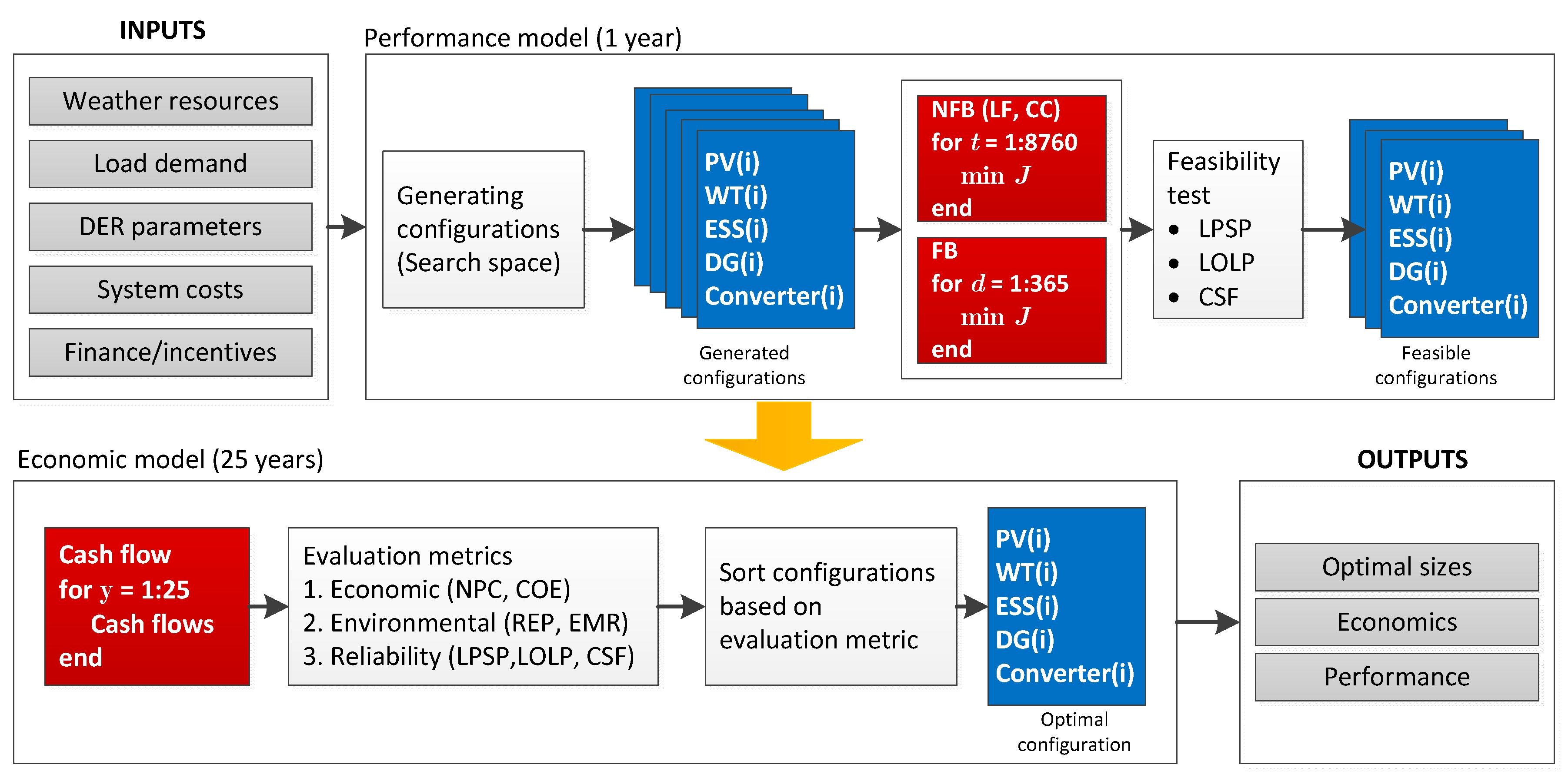
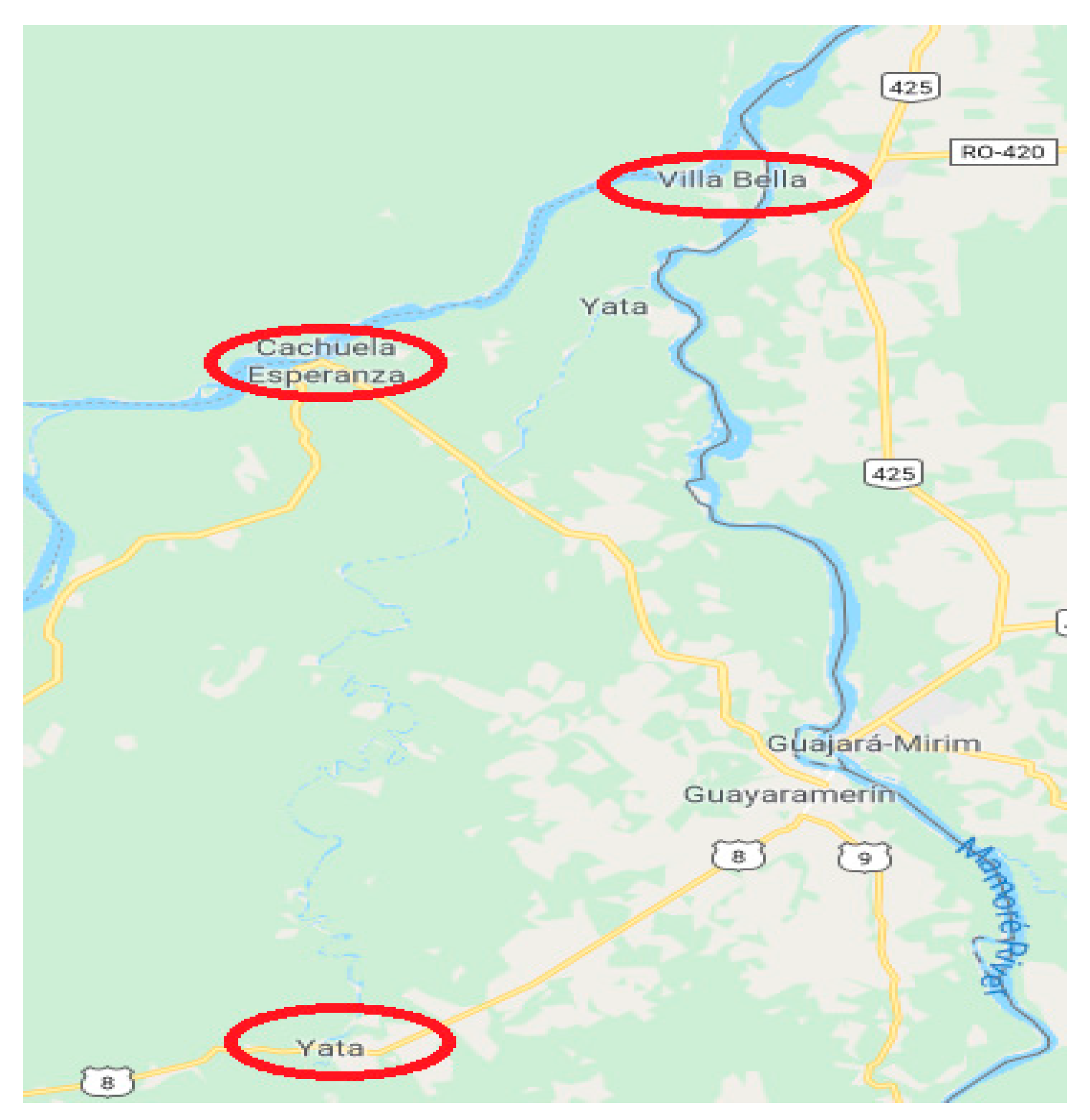
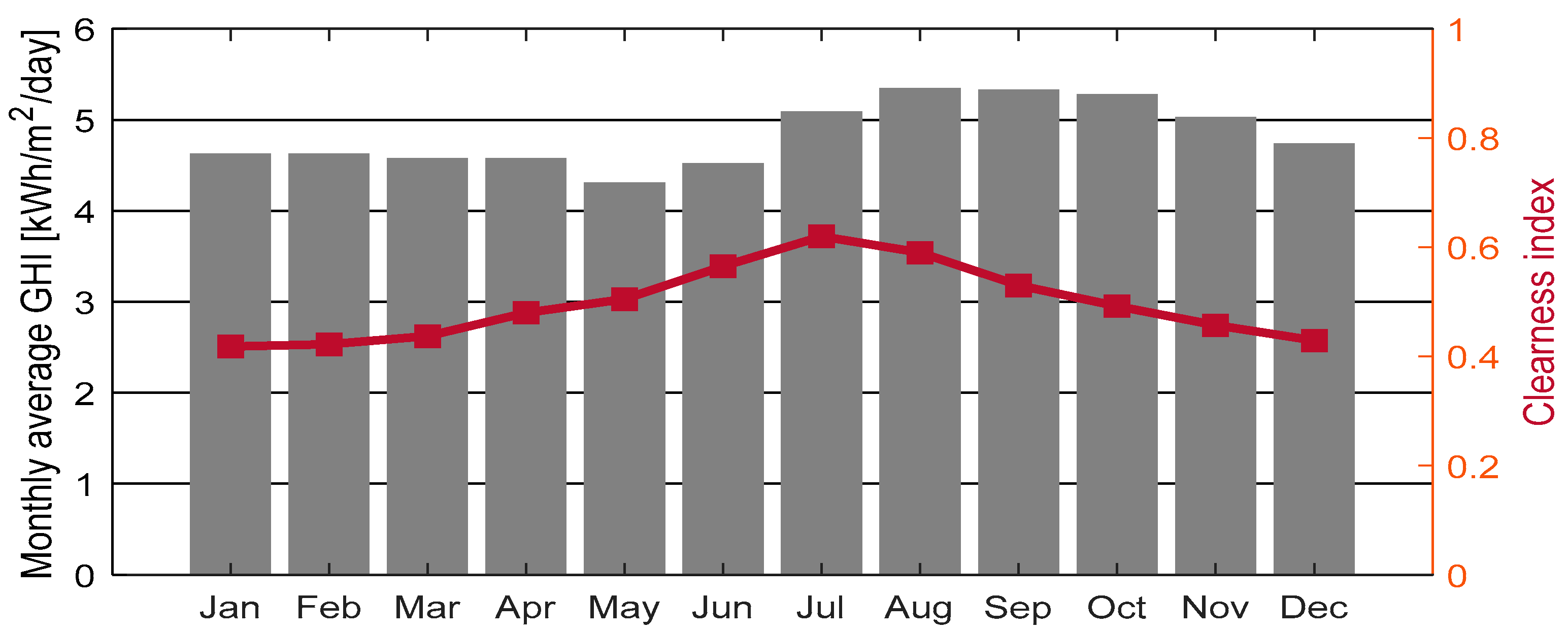
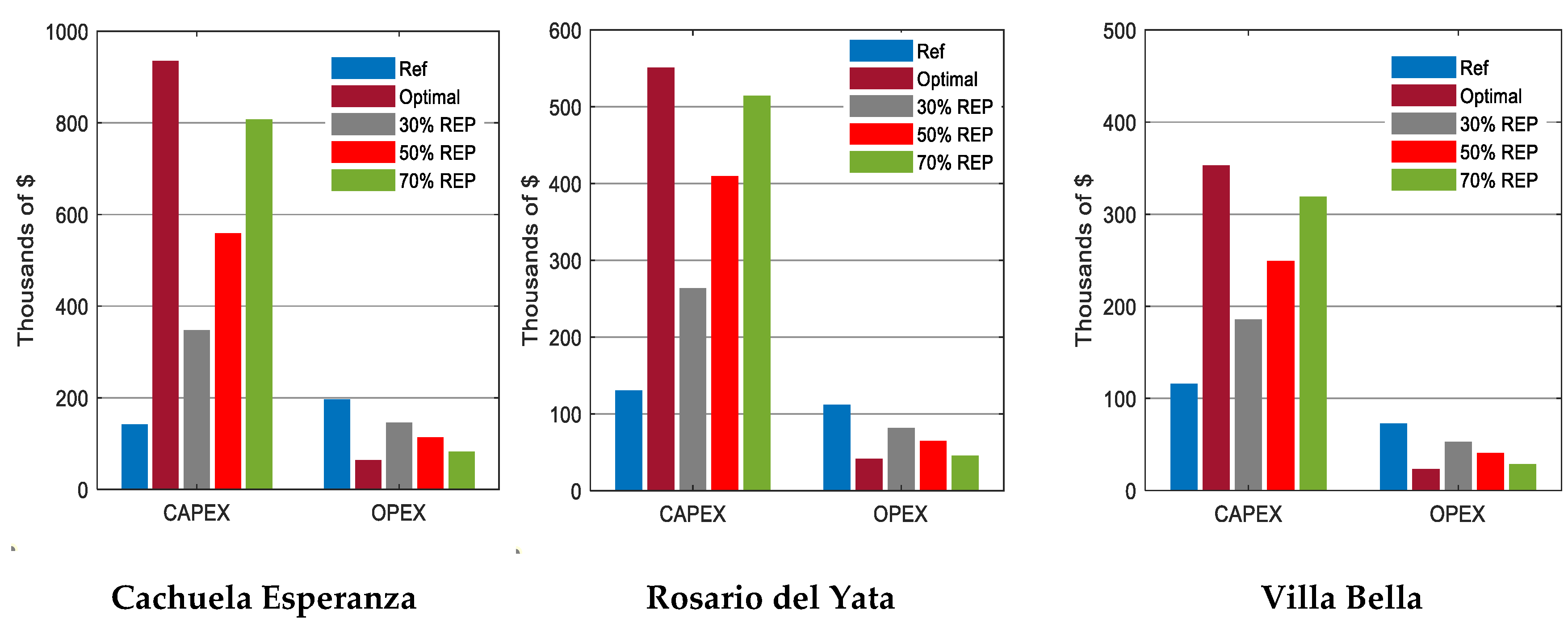
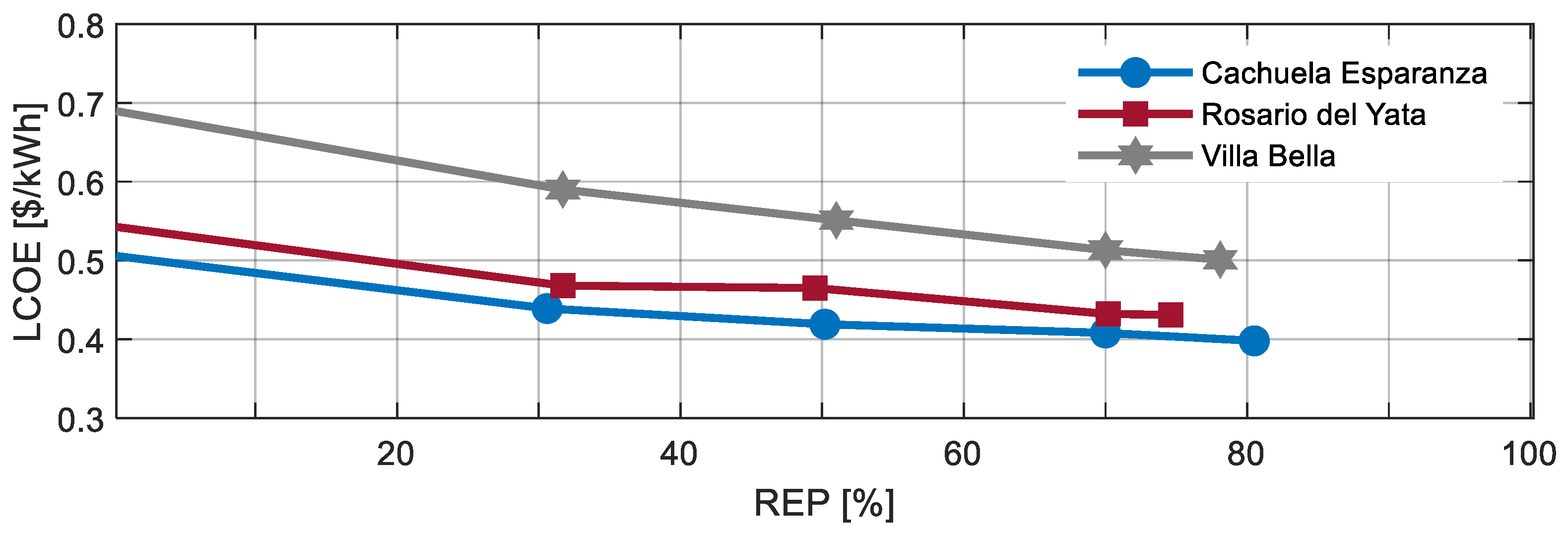
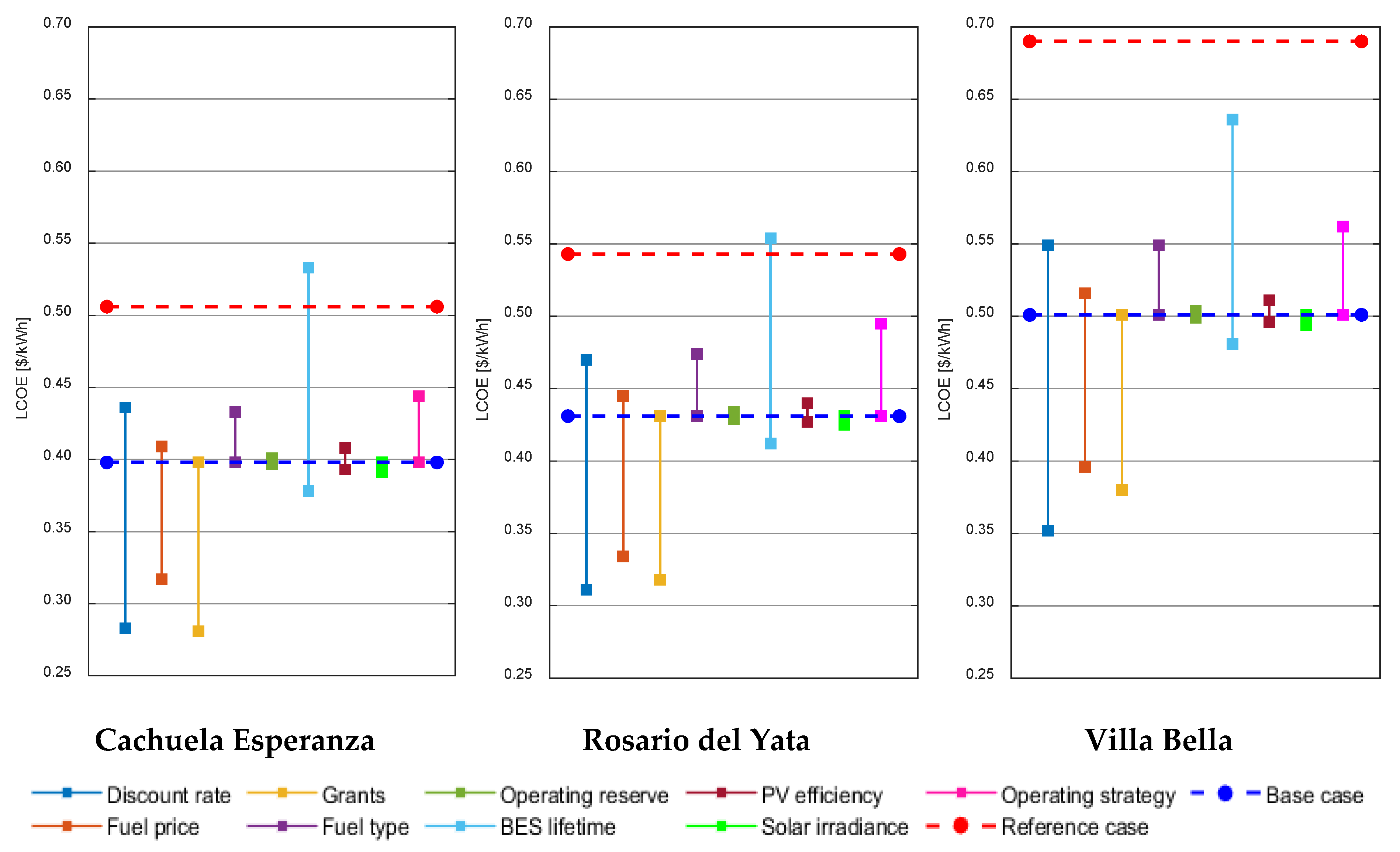
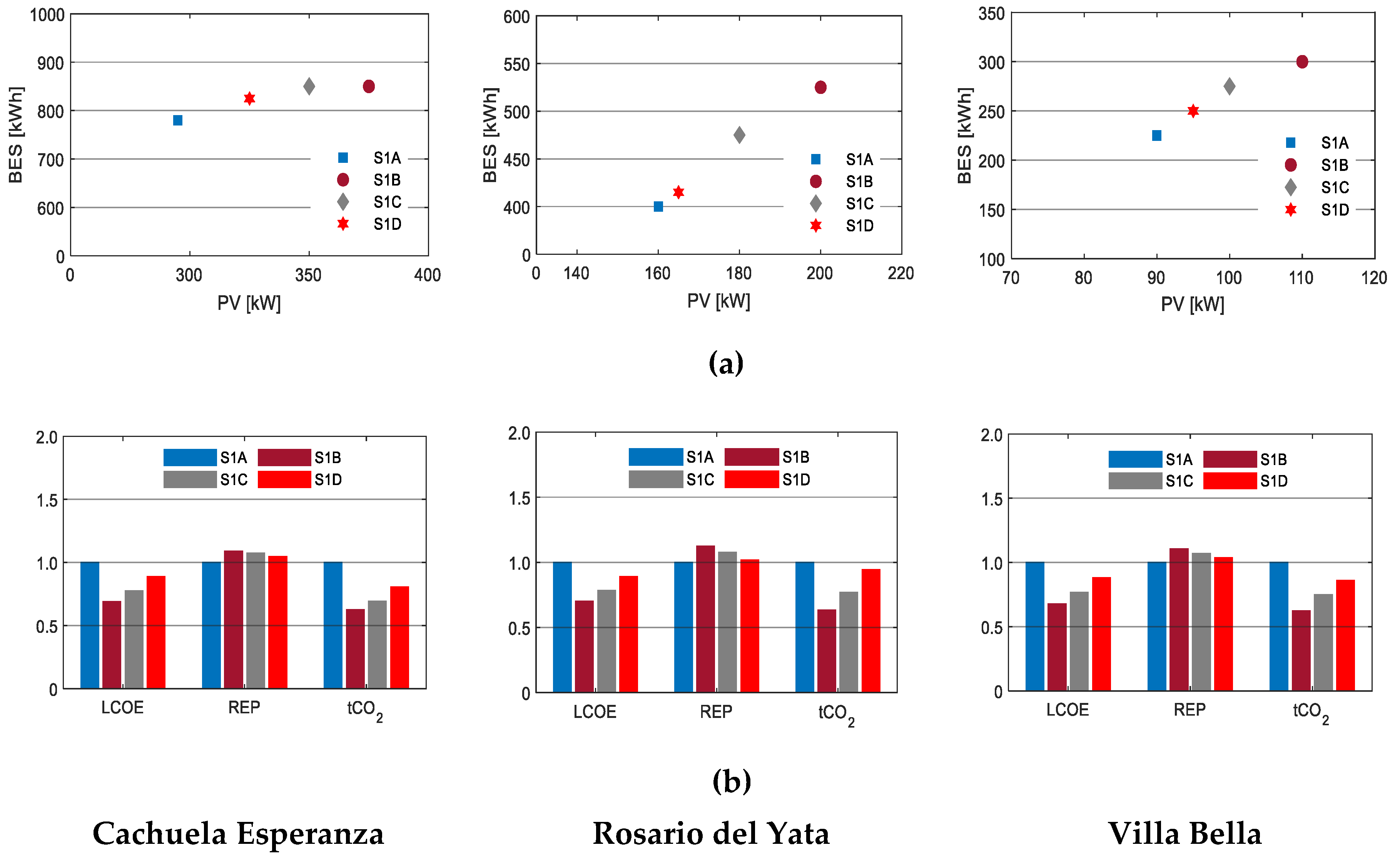
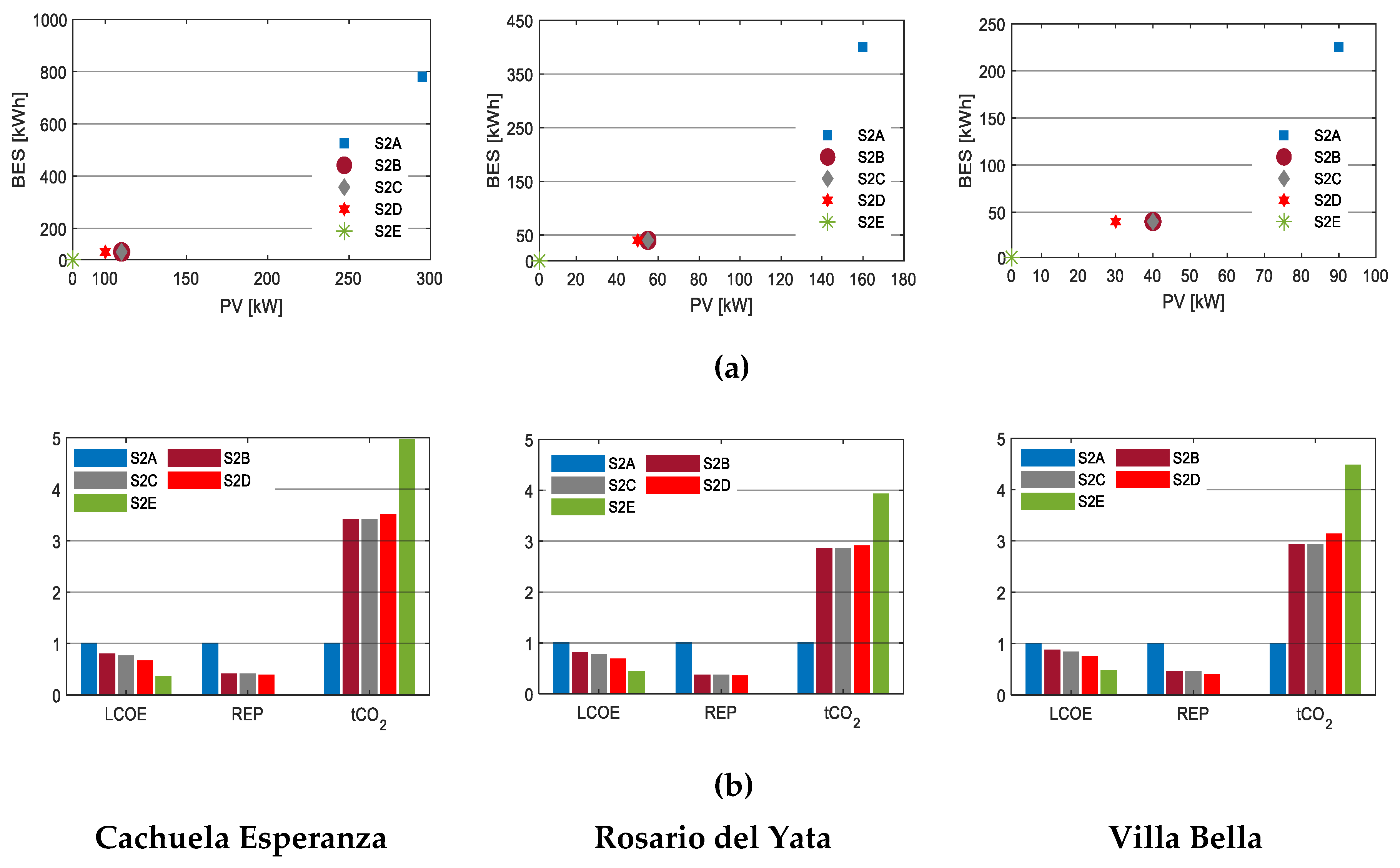
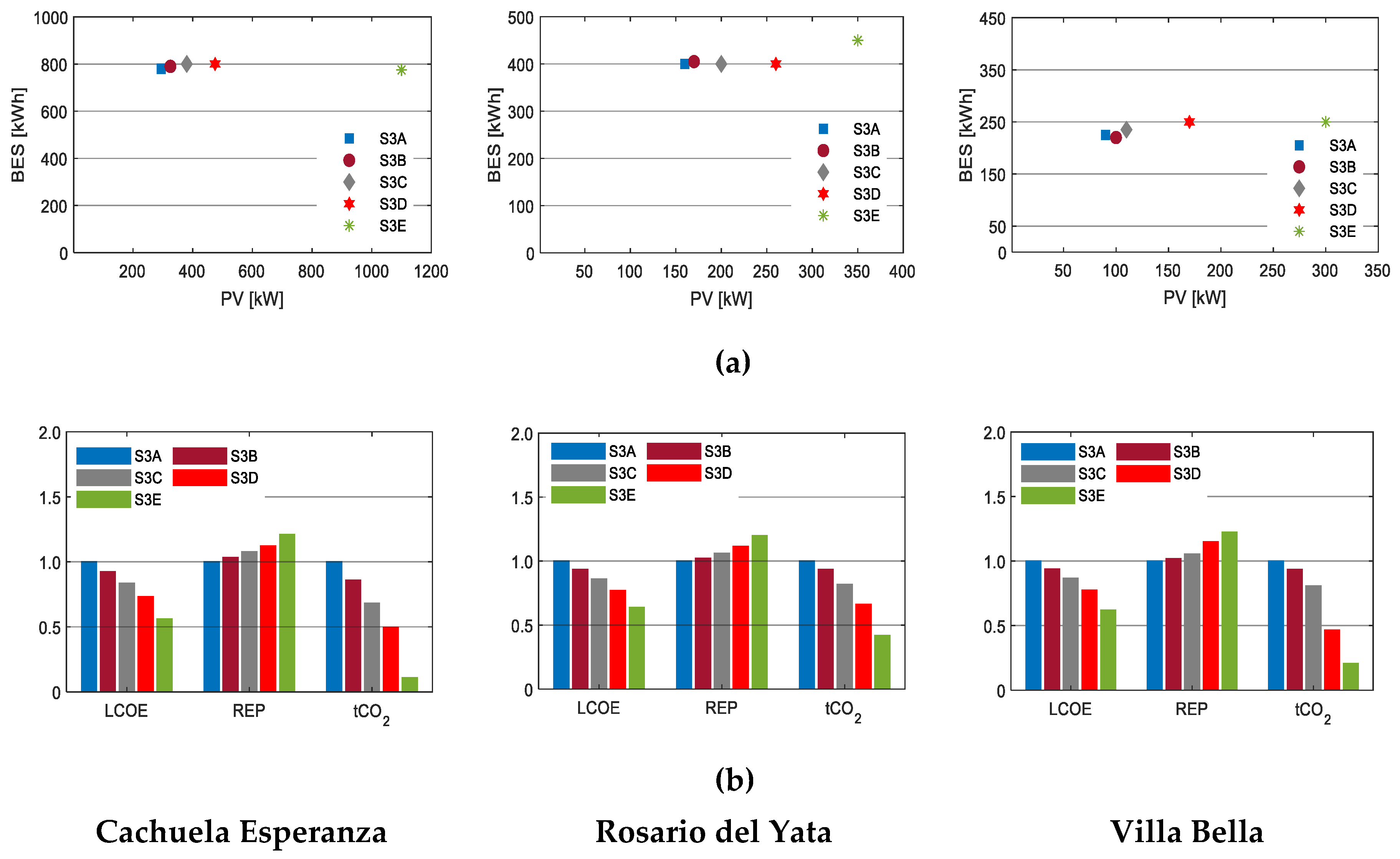
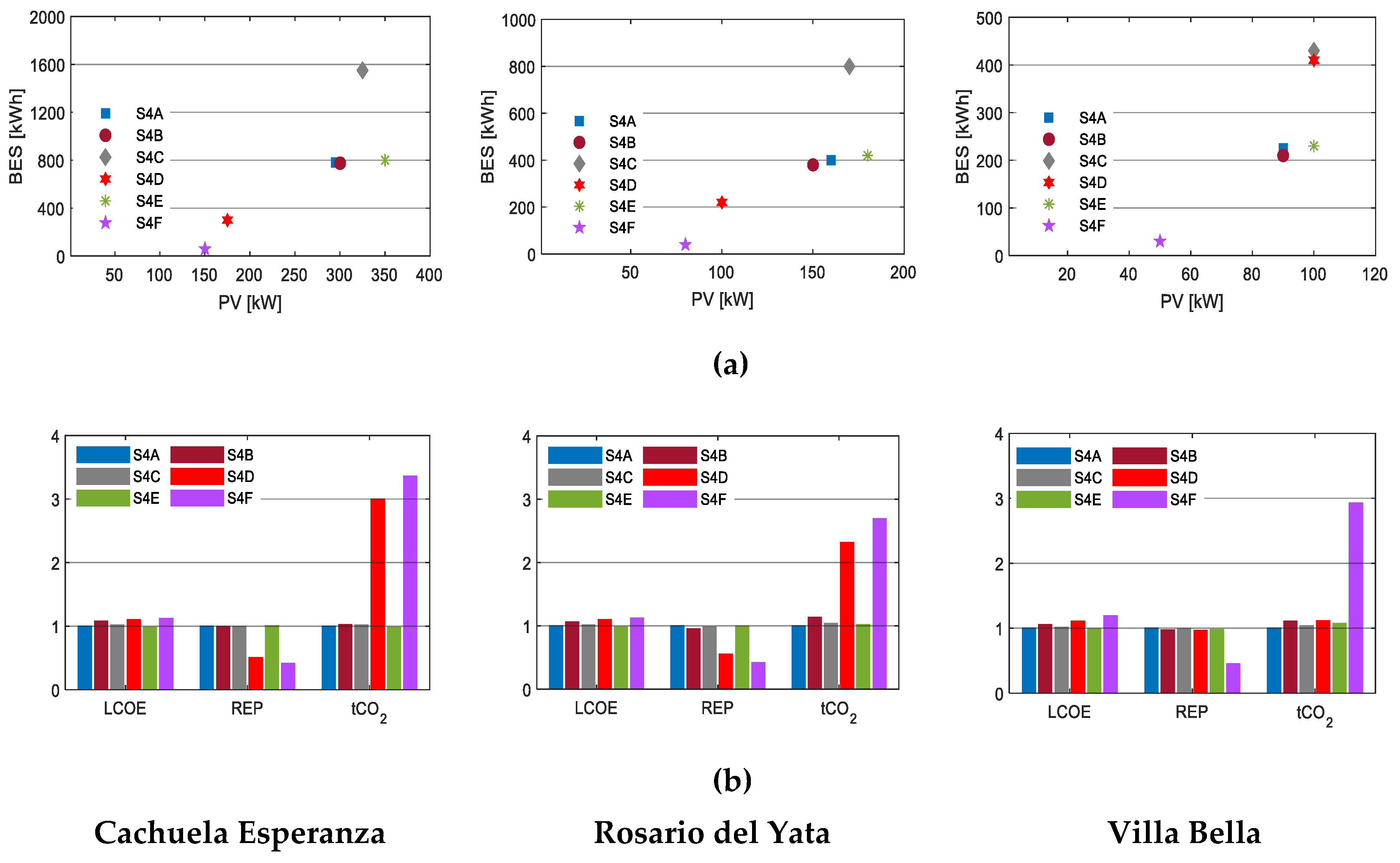
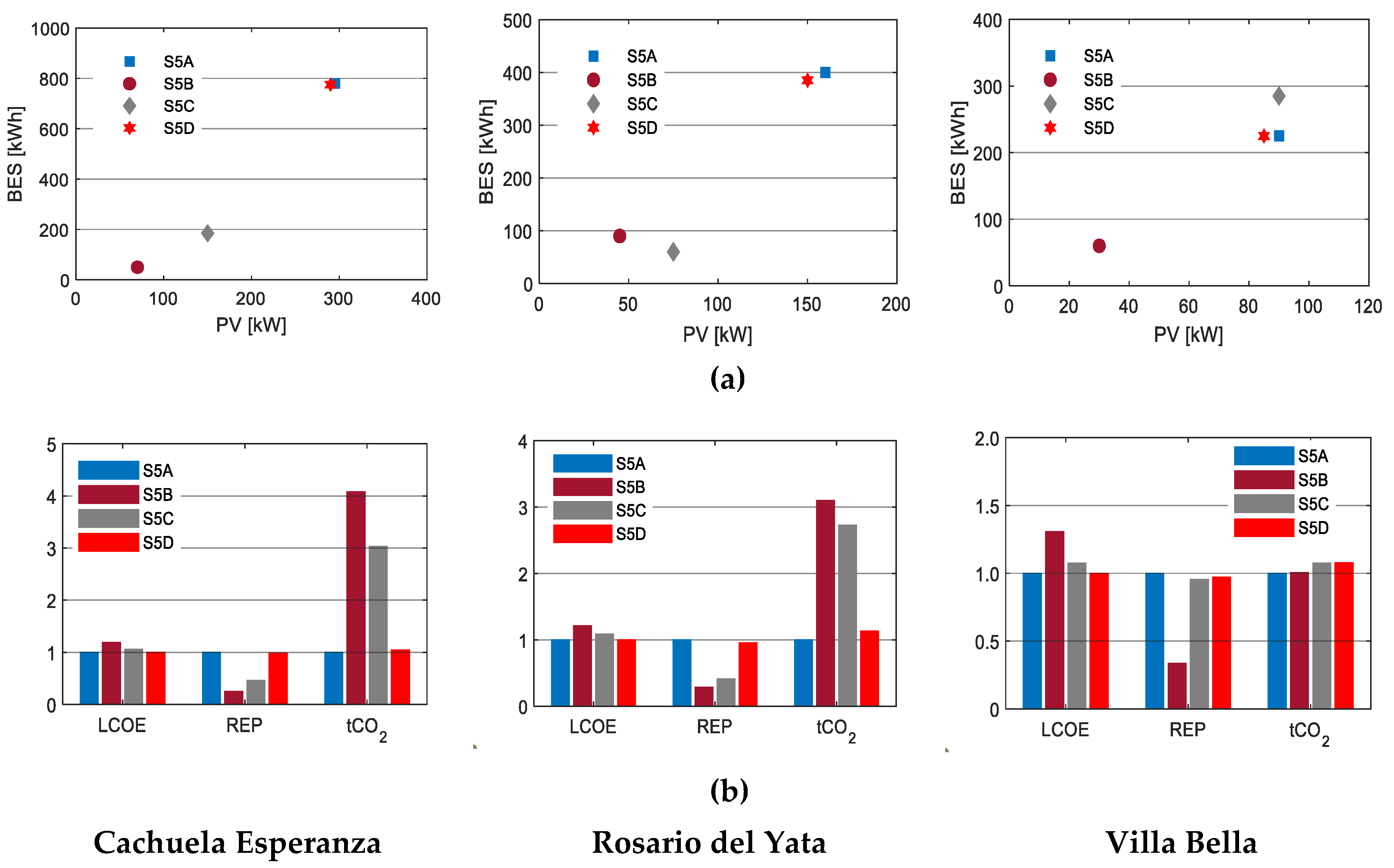
| Location Information | Cachuela Esperanza | Rosario del Yata | Villa Bella |
|---|---|---|---|
| Latitude | 10°32′13″ S | 10°59′34″ S | 10°23′47″ S |
| Longitude | 65°34′52″ W | 65°34′43″ W | 65°23′31″ W |
| Households | 150 | 116 | 48 |
| Population | 800 | 540 | 200 |
| Parameter | Cachuela Esperanza | Rosario del Yata | Villa Bella |
|---|---|---|---|
| Peak demand (kW) | 72 | 54 | 27 |
| Min. demand (kW) | 24 | 14 | 8 |
| Avr. demand (kW) | 47 | 27 | 14 |
| Load factor | 0.67 | 0.50 | 0.52 |
| Ann. average (kWh/day) | 1,138 | 643 | 336 |
| Parameters | Value | Units |
|---|---|---|
| Photovoltaic | - | - |
| Module power | 370 | Wdc/module |
| Nominal efficiency | 19.0 | % |
| Max. power voltage/current | 39.8/9.29 | Vdc/Adc |
| Lifetime | 25 | yr. |
| BES | - | - |
| Type | Li-ion | - |
| Chemistry | NMC | - |
| Round-trip efficiency | 95 | % |
| Depth of discharge | 90 | % |
| Lifetime (throughput) | 2,000 | kWh/1 kWh |
| Lifetime (calendar) | 12 | Yr. |
| Converter | - | - |
| Rated AC frequency | 50 | Hz |
| European weighted efficiency | 98.0 | % |
| CEC weighted efficiency | 98.2 | % |
| Lifetime | 12.5 | yr. |
| Diesel generator | - | - |
| Minimum load ratio | 25 | % |
| Engine speed | 1,500 | RPM |
| Frequency | 50 | Hz |
| Lifetime | 60,000 | Hours |
| Parameters | Value | Units |
|---|---|---|
| Photovoltaic | - | - |
| Capital cost | 1,500 | $/kW |
| O&M cost | 10 | $/kW/yr |
| BES | - | - |
| Capital cost | 420 | $/kWh |
| O&M cost | 10 | $/kWh/yr |
| Replacement cost | 200 | $/kWh |
| BSS inverter | - | - |
| Capital cost | 200 | $/kW |
| Replacement cost | 200 | $/kW |
| Diesel generator | - | - |
| Capital cost | 500 | $/kW |
| O&M cost | 0.03 | $/kW/hr |
| Replacement cost | 500 | $/kW |
| Fuel cost | 1.41 | $/l |
| Control & monitoring | 100,000 | $ |
| Parameters | Ref. | 30 % REP | 50 % REP | 70 % REP | Optimal |
|---|---|---|---|---|---|
| PV (kW) | - | 100 | 170 | 270 | 295 |
| BES (kWh) | - | 100 | 350 | 575 | 780 |
| Inverter (kW) | - | 70 | 80 | 100 | 120 |
| DG (kW) | 80 | 80 | 80 | 80 | 80 |
| REP (%) | 0 | 30.6 | 50.2 | 70.0 | 80.5 |
| LCOE ($/kWh) | 0.506 | 0.439 | 0.419 | 0.408 | 0.398 |
| CAPEX ($) | 140,000 | 346,000 | 558,000 | 806,500 | 934,100 |
| OPEX ($/y) | 195,011 | 144,247 | 112,502 | 80,582 | 62,495 |
| Battery life (y) | - | 8.4 | 8.7 | 7.8 | 8.3 |
| Fuel (L/y) | 120,581 | 85,297 | 61,716 | 37,486 | 24,279 |
| Emission (ton/y) | 315.7 | 223.3 | 161.6 | 98.1 | 63.6 |
| Parameters | Ref. | 30 % REP | 50 % REP | 70 % REP | Optimal |
|---|---|---|---|---|---|
| PV (kW) | - | 65 | 140 | 140 | 160 |
| BES (kWh) | - | 60 | 140 | 385 | 400 |
| Inverter (kW) | - | 50 | 50 | 60 | 60 |
| DG (kW) | 60 | 60 | 60 | 60 | 60 |
| REP (%) | 0 | 31.7 | 49.5 | 70.2 | 74.6 |
| LCOE ($/kWh) | 0.543 | 0.468 | 0.465 | 0.432 | 0.431 |
| CAPEX ($) | 130,000 | 262,700 | 408,800 | 513,700 | 550,000 |
| OPEX ($/y) | 111,098 | 80,863 | 64,080 | 44,828 | 40,548 |
| Battery life (y) | - | 7.3 | 6.9 | 8.6 | 8.3 |
| Fuel (L/y) | 66,918 | 45,747 | 33,798 | 19,961 | 17,033 |
| Emission (tCO2/y) | 175.2 | 119.8 | 88.5 | 52.3 | 44.6 |
| Parameters | Ref. | 30 % REP | 50 % REP | 70 % REP | Optimal |
|---|---|---|---|---|---|
| PV (kW) | - | 30 | 50 | 70 | 90 |
| BES (kWh) | - | 50 | 125 | 220 | 225 |
| Inverter (kW) | - | 20 | 30 | 30 | 40 |
| DG (kW) | 30 | 30 | 30 | 30 | 30 |
| REP (%) | 0 | 31.7 | 51.0 | 70.0 | 78.1 |
| LCOE ($/kWh) | 0.690 | 0.590 | 0.551 | 0.513 | 0.501 |
| CAPEX ($) | 115,000 | 185,000 | 248,500 | 318,400 | 352,500 |
| OPEX ($/y) | 71,989 | 51,956 | 40,158 | 27,786 | 22,606 |
| Battery life (y) | - | 9.9 | 9.2 | 9.5 | 8.4 |
| Fuel (L/y) | 44,409 | 30,810 | 22,322 | 13,608 | 9,927 |
| Emission (ton/y) | 116.3 | 80.7 | 58.4 | 35.6 | 26.0 |
| Parameter | Nominal | Variation | Ref. |
|---|---|---|---|
| Policy | - | - | - |
| Discount rate | 10% | 3%–12% | [64,65] |
| Diesel price | 1.41 $/l | 0.16–1.41 $/l | [66] |
| Grant | 0% | 0%–100% | - |
| Technology | - | - | - |
| BES lifetime | 2000 cycles | 500–4000 cycles | [64] |
| Operating strategy | LF | CC, LF-ON, FB | [55] |
| PV efficiency | 19% | 13% | - |
| Fuel type | Diesel | LPG | - |
| Operating reserve | 80% of PV power | 70–90% | [67] |
| Solar irradiance | NASA | Pvwatts | [61] |
| Properties | Lithium-ion Battery | Lead-acid Battery | Flow Battery | |||
|---|---|---|---|---|---|---|
| NMC | LFP | FLA | VRLA | VRFB | ZBFB | |
| Installation cost ($/kWh) | 420 | 578 | 147 | 263 | 347 | 900 |
| Throughput lifetime (cycles) | 2000 | 2500 | 1500 | 1500 | 13000 | 10000 |
| Calendar lifetime (years) | 12 | 12 | 9 | 9 | 12 | 10 |
| Depth of discharge (%) | 90 | 90 | 50 | 50 | 100 | 100 |
| Round-trip efficiency (%) | 95 | 92 | 82 | 80 | 70 | 70 |
© 2020 by the authors. Licensee MDPI, Basel, Switzerland. This article is an open access article distributed under the terms and conditions of the Creative Commons Attribution (CC BY) license (http://creativecommons.org/licenses/by/4.0/).
Share and Cite
Husein, M.; Kim, H.-J.; Chung, I.-Y. The Impact of Policy and Technology Parameters on the Economics of Microgrids for Rural Electrification: A Case Study of Remote Communities in Bolivia. Energies 2020, 13, 877. https://doi.org/10.3390/en13040877
Husein M, Kim H-J, Chung I-Y. The Impact of Policy and Technology Parameters on the Economics of Microgrids for Rural Electrification: A Case Study of Remote Communities in Bolivia. Energies. 2020; 13(4):877. https://doi.org/10.3390/en13040877
Chicago/Turabian StyleHusein, Munir, Hyung-Ju Kim, and Il-Yop Chung. 2020. "The Impact of Policy and Technology Parameters on the Economics of Microgrids for Rural Electrification: A Case Study of Remote Communities in Bolivia" Energies 13, no. 4: 877. https://doi.org/10.3390/en13040877
APA StyleHusein, M., Kim, H.-J., & Chung, I.-Y. (2020). The Impact of Policy and Technology Parameters on the Economics of Microgrids for Rural Electrification: A Case Study of Remote Communities in Bolivia. Energies, 13(4), 877. https://doi.org/10.3390/en13040877





